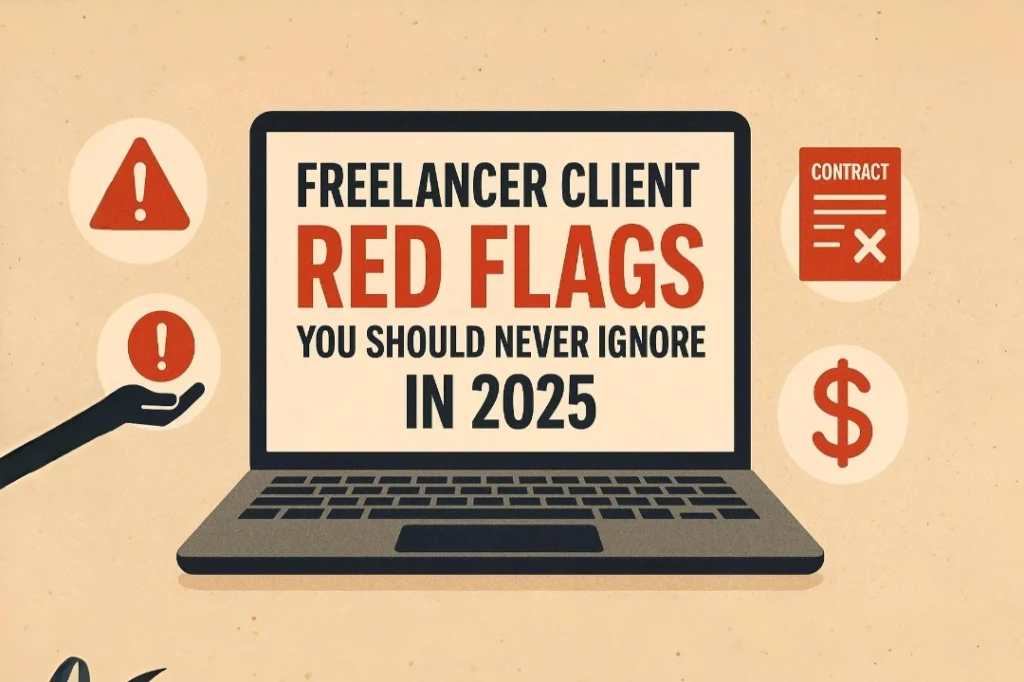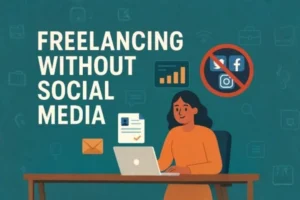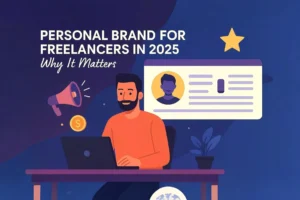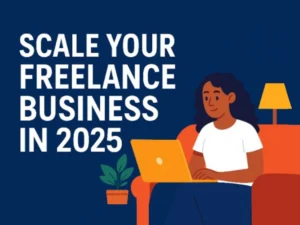Freelancer Client Red Flags You Should Never Ignore in 2025
Choosing and selecting your clients wisely can break or make your freelancing career—especially in today’s fast-paced digital era. Identifying the freelancer client red flags is no longer a helpful tip—it’s a survival reflex. With more freelancers than ever pitching worldwide in 2025, the wrong clients can drain your time, energy, and profits into thin air in no time.
Freelancing offers autonomy, adaptability, and artistic control—if you have the right type of clients. The wrong client can result in payments missed or delayed, unrealistic expectations, or worse, burnout. Newbie freelancer or seasoned pro, it’s best to learn these warning signs early on to preserve your business and your sanity.
Here in this post, we’ll tackle the largest client red flags freelancers need to watch out for in 2025—based on actual experience, industry insight, and the constantly evolving realms of remote work. From vague scopes and ghosting to slow pay and scope creep, we’re calling out the subtle (and not-so-subtle) cues that should steer you clear.
Because in freelancing, time equals money—and accepting the wrong clients will cost you both.
Why Red Flags Matter for Freelancers in 2025
In this freelance reality of ours that’s changing at warp speed, knowing how to spot freelancer client red flags is more important than ever. In 2025, with oversaturated sites and competition being fierce, being able to spot bad clients from the start is not only something to have an asset for—it’s a matter of survival.
Worst clients are worth more than a wage. They can destroy your reputation, drain your energy, and rob you of better prospects. If they are late-paying clients, who always delay deadlines or request gratis revisions beyond scope, disregarding these red flags can give you stress, burnout, and revenue uncertainty.
On the other hand, understanding how to identify and avoid such pitfalls spares you the headache of defending your business, your sanity, and your time. It allows you to have the luxury of working with well-paying, respectful clients who appreciate the amount of effort you put into your work. In short, having the ability to identify red flags earlier enables you to grow with confidence instead of always fighting fires.
By 2025, successful freelancers won’t just be skillful at what they do—they’ll also have some inkling about managing client relationships. And that starts with knowing when to walk away before it’s going to cost you more than it’s worth.
Want to go even deeper into smart freelancing? Check out our full guide on how to attract high-paying freelance clients in 2025.
Top 10 Freelancer Client Red Flags
1. Vague Project Scope or Expectations
One of the biggest freelancer client red flags is a client who can’t clearly explain what they want. If a project starts with phrases like “We’ll figure it out as we go” or “It’s a pretty simple task, you’ll get it,” proceed with caution. Uncertain project scopes typically result in countless revisions, shifting objectives, and a great deal of time wasted.
Delivering something that the client is satisfied with is practically impossible when expectations aren’t clearly stated from the beginning because even they are unsure of what that is. This often results in scope creep, confusion, and misaligned outcomes that hurt both your workflow and your client relationship.
As a freelancer in 2025, your time is valuable. You should never have to guess what the deliverables are or how success will be measured. A good client will take the time to explain their goals, provide examples, and work with you to set measurable objectives. If they can’t—or won’t—do that, it’s a major red flag and a signal to either clarify things fast or walk away.
2. Refuses to sign a Contract
If a client says, for instance, “We don’t need a contract — let’s just trust each other,” that’s a big red flag waving in your face. It might be a seemingly casual, laid-back arrangement initially, but leaving out a written agreement will most of the time lead to misunderstandings, creepage of scope, slow payments, or worse—no payment at all.
As independent contractors, we must protect our time and effort. A good agreement doesn’t just set up deliverables and deadlines—it sets limits, builds trust, and gives both sides something concrete to go back to when things go wrong. Without it, you’re relying only on good faith, and regretfully, that’s not always enough.
Need to build your freelance business in 2025? Then treat each client relationship like a business transaction. Professionalism is not just what you can do; it’s also what you do to protect what you build. Even a simple written agreement or email establishing terms is better than nothing. If a client pushes back on this, wonder why—and whether they’re ultimately someone you want to work with. If you’re just getting started, don’t miss our guide on how to start freelancing the right way in 2025.
3. Pushes for Unreasonable Deadlines
One of the biggest red flags you’ll encounter as a 2025 freelancer is a client who consistently requests unrealistic deadlines. They’ll make a comment like, “This shouldn’t take long,” or “Can you have it back by tonight?” without considering the amount of work or your existing workload. It’s normally an indication they don’t value your time—or worse, they don’t fully understand the creative or technical process of your work.
Rushing projects not only leads to burnout but can also undermine the quality of your deliverables and damage your professional reputation. You’re trading accuracy and consideration for the sake of meeting someone else’s chaotic timeline. That’s not feasible—especially if you’re trying to boost your productivity as a remote freelancer.
If a potential client refuses to move on timing or disregards your process, you have to ask: will this client be more headache than they’re worth? In most cases, it’s better to walk away than to accept a deadline that sets you up for failure. Want to avoid these traps in the first place? Freelancers can usually sidestep them by setting expectations upfront and using written contracts that outline timelines and deliverables.
And if you’re still wondering how to push back professionally, this guide on setting boundaries with freelance clients from Freelancers Union is a great place to start.
4. Talks Down Your Rates
If there is one red flag that longtime freelancers pick up on right away, it is the client who immediately asks or tries to negotiate your rates—especially before they get a sense of the value you provide. You might overhear something like, “That’s a bit too expensive for this kind of job,” or “I know someone who can get it done cheaper.” Negotiating budgets is okay, but ongoing attempts to undercut your work are not.
When somebody tries to negotiate your rates down, it usually means they don’t have a lot of respect for your time, skill, or quality of work. And in 2025, when AI programmes and web-based platforms are raising expectations across all industries, underpriced yourself just to secure the job is a fast route to exhaustion. You deserve to get paid what you’re worth—especially if you’ve invested decades honing your craft or specialist knowledge.
Learning to bring in high-paying freelance clients is important for both keeping up income and self-confidence in this competitive world. It’s not about the money—it’s about working with clients who respect your worth and desire to invest in long-term relationships, not try to get away cheaply.
Still unsure if you’re getting the right rate? Check out this handy article on how to charge fairly for freelance services from Shopify’s blog—it offers smart, practical tips you can apply right away.
5. Poor or Infrequent Communication
Among the most maddening freelancer client red flags is poor communication. If you’re wasting all your time waiting around for feedback, pestering for responses, or getting fluff messages that leave you running in circles, it’s a sign the working relationship may be more bother than it’s worth.
Good clients respect your time and understand that plain, steady communication is the most essential thing about delivering quality work. Bad clients who go missing for days and return asking for instant news can derail your schedule, create confusion, and ultimately affect the quality of the final product.
Pay close attention during the discovery process to the client’s responsiveness. Do they answer you directly when you ask questions? Are they engaged in the process or seem distracted and uncaring? These warning signs will save you from weeks of frustration later on.
If you’re dealing with a client who barely communicates, it’s tough to know if you’re on the right track. That ambiguity can make even experienced freelancers second-guess their work. Don’t be afraid to address the issue directly—and if it doesn’t improve, it may be best to walk away.
6. Disrespects Boundaries or Time Zones
One of the most frustrating client red flags when freelancing is when someone habitually ignores your work hours, personal boundaries, or time zone differences. You might say you’re unavailable after a certain time, and wake up to five missed messages marked “urgent.” Or maybe they expect instantaneous replies, even on weekends or holidays. This is not only stressful—it’s not sustainable.
Remote freelancing in 2025 means you can work from anywhere, but that does not mean you are always on. Client relationships that are respectful are built on the foundations of respect, like respect for time zones, windows of work, and work-life balance. If a client is unable to respect those basic parameters, it’s usually an indication of a disorganized, demanding experience that wears away at your peace of mind.
If you’re juggling a number of projects across a range of clients and time zones, then it’s time to master expectation management. Here’s one resource that can help you do it better: Manage Multiple Clients as a Freelancer in 2025. It contains some handy advice on how to stay on top without burning out.
7. Multiple Rounds of Revisions “Included”
We’ve all been there. You deliver what you know is the final draft of a project, and then the client calls with “just a couple of minor tweaks.” But those two or three revisions become five, ten, or more rounds of revisions—and you’re being paid not more than your flat fee. That’s not only frustrating, it’s a huge red flag.
When a client expects unlimited revisions or doesn’t define what’s “reasonable,” it usually means they haven’t thought the project through—or they’re trying to squeeze extra work without paying for it. In 2025, freelancers can’t afford to give away their time like that. Your hours are valuable, and if you’re constantly stuck in revision loops, it’s hard to grow or take on other clients.
That’s why it pays to have a clear revision policy upfront. Spell it out in your contract or proposal—how many rounds are included, what is a revision, and what if they need more. It keeps the whole project on track and saves your time.
If you’re not sure how to set those boundaries, check out our article on getting paid faster as a freelancer. It dives into practical ways to structure your client agreements so you’re not left doing unpaid work over and over again.
8. Negative Reviews from Other Freelancers
In today’s age of freelance, it’s easier—and more important—than ever to do a quick background check on a potential client. If there are nasty reviews and complaints from other freelancers, pay attention. Bad reputations don’t typically materialize overnight. Whether on platforms like Upwork, Fiverr, Reddit, or by way of Facebook groups, those warning signs can help save you hassle down the road.
Regularly underpaying, ghosting after they place an order, or demanding unrealistic results typically leave a trail. And with the internet forums, freelancers have more channels to warn each other. If you notice repeated complaints—like “never paid,” “micromanages,” or “pressures for free extras”—you’d do better to get out before you get caught in the same trap.
Though everyone is entitled to the benefit of the doubt, repeated bad news never happens by chance. Trust your instincts, but take guidance from the freelance community as well. Staying informed is one of the shrewdest means to safeguard both your paycheck and peace of mind.
Want to strengthen your client-vetting process? Our article on how to find high-paying freelance clients in 2025 provides valuable insights to help you choose clients who appreciate your time, rate, and skills.
9. Scope Creep Without Extra Pay
This is the most common—and most insidious—client freelancer warning sign. It starts innocently enough. A client asks “just one little tweak,” then another, and you’re soon doubling your work without seeing an extra penny. This is called scope creep, and it can quietly chew away at your time, profit, and passion.
Professional clients know that more work equals more pay. But red-flag clients? They’ll try to blur the lines, hoping you’ll fail to notice or feel too awkward to complain. It leaves you in a tricky spot where a no may seem like endangering the project, but a yes equals working for nothing.
The best defense is clear communication and airtight contracts. Be sure to outline exactly what’s included in your deliverables, how many revisions are allowed, and what happens if the scope changes. That way, you’re protected—and your boundaries are respected.
10. Late or Complicated Payment Processes
Getting paid should not be a part-time job. But if a client’s paying invoices slowly, evading payment reminders, or leaping through unnecessary hurdles for you, consider it a giant red flag. You’re not a bank—they shouldn’t be borrowing your time and energy without timely repayment.
Freelancers require regular cash flow to survive, and clients who are slow with payments jeopardize your business and your sanity. Whether excuses are given that “accounting is slow this week” or the systems are complicated and require many follow-ups, these are all signs that payment will be harder than it has to be.
Reliable customers respect your work—and that entails paying you in a timely manner. Always specify payment terms beforehand, such as deadlines and penalties for being late. When the client is evasive or confrontational when discussing finances, take it as a warning sign prior to agreeing.
How to Spot These Red Flags Early
The best way to defend yourself against problematic clients in 2025 is to spot the red flags before you ever agree to accept the work. While some issues don’t show up until the middle of the project, many telltale signs are found right in that initial e-mail or phone call—if you know what to look for.
Begin by noticing carefully how a prospective client communicates. Are they vague in their messages, too demanding, or too quick? Do they ignore introductions and immediately jump into what they desire, without regard for your time? These are often the subtle hints of how they will act once they sign on the dotted line.
Discovery calls are a red flag moment too. If a client evades your questions about budget, scope, or timeline—or worse, interrupts you or plays down your experience—that’s your cue to slow down. Freelancers who don’t listen to their instincts always regret it later.
To screen clients more effectively, attempt to utilize tools meant to streamline onboarding and protect your process. HoneyBook and Bonsai permit you to send proposals, contracts, and invoices from one central point—making it easier to know clients who hesitate when signing is imminent. Notion is also a great way to keep red flags in mind, track client feedback, and improve your screening system with time.
In other words, trust your gut—but also use systems and tools that help you remain professional, efficient, and ahead of the curve. Seeing red flags early on won’t only spare you stress—it can actually lead to better, more high-quality clients.
What to Do If You’ve Already Said Yes
We’ve all been there—you agree to a freelance project that sounds great at first, only to discover the client is difficult, unclear, or even disrespectful. The good news? You’re not stuck. There are professional ways to manage the situation, protect your peace, and either improve the working relationship or exit gracefully.
Start by referencing your original agreement or contract. If the client is requesting more than you originally agreed upon—extra revisions, tighter deadlines, or more scope—it’s perfectly acceptable to refer to that. Frame your note diplomatically: “Hello, I noticed we’re going over the initial agreement. Would you mind adjusting the scope or budget to factor in that?” Most thoughtful clients will understand.
When things are not going right, regular check-ins can reset expectations. Establish nice but firm boundaries. Shared timelines, task boards (even a very basic Notion workspace), or structured feedback sessions can get both parties back on the same page.
But suppose the relationship can’t be saved? Then it’s absolutely okay to let it go—dignifiedly. Offer notice, pay up, and propose calling it a day in a neat package. Your mental health and long-term prosperity are worth an awful lot more than a dismal client.
It also helps to be ready next time. Apply what you have learned to enhance the manner in which you screen clients before you start any project. Our article on finding high-paying freelance clients in 2025 explains how to attract better-fit opportunities and recognize good clients early on.
And if you’ve been underpaid or taken advantage of, don’t fret, you’re not alone. Do remember to look over these strategies for getting paid faster and protecting your income in the future.
Protecting Yourself Going Forward
Half the battle of being able to see the freelancer client red flags is recognizing them—the true strength is being guarded before you ever sign a contract. In 2025, exceptional freelancers aren’t just good at their job—on top of that, they’re master boundary-setters and guardians of their business from day one. And that begins with good communication, clear documentation, and planning ahead.
A good contract is your armor. It does not need to be in legalese but it should have a clear definition of scope of work, timelines, payment terms, revisions limits, and expectations.
Another smart move is the advance deposit. That’s not about dollars—it’s about trying the client and how to make your time pay off. Whether payment milestone by milestone or 30% down payment, deposits reduce risk and increase both parties’ commitment.
Finally, develop the practice of making things clear. Get things out front in writing, confirm in writing, and don’t be afraid to question where something doesn’t sound right. In this manner, you can avoid stress resulting from flaky projects and professionalize—and profit from—every client relationship.
Final Thoughts: Trust Your Gut
At the end of the day, your intuition is one of the most powerful tools you have. If something feels off during early conversations or a client raises subtle concerns, don’t brush it aside. Most seasoned freelancers will tell you—your gut is rarely wrong.
The ability to spot freelancer client red flags is a skill that gets better with time, experience, and yes, occasionally a few challenging lessons. However, you can better safeguard your time, energy, and money if you know what to look for.
In 2025, there will be plenty of opportunities for freelance work, but not every client is worth the deal. Always value your work, establish clear expectations, and maintain your boundaries. When in doubt, keep in mind that the right clients value your process, and if you’re paying attention, the wrong ones will show themselves right away.
You can also read: How to Build a Personal AI Assistant in 2025 (No Coding)
20 Passive Income Ideas for 2025 That Actually Work
💌 Enjoying these freelancing tips? Subscribe to our newsletter and get smart strategies, tools, and money hacks delivered straight to your inbox every week.





